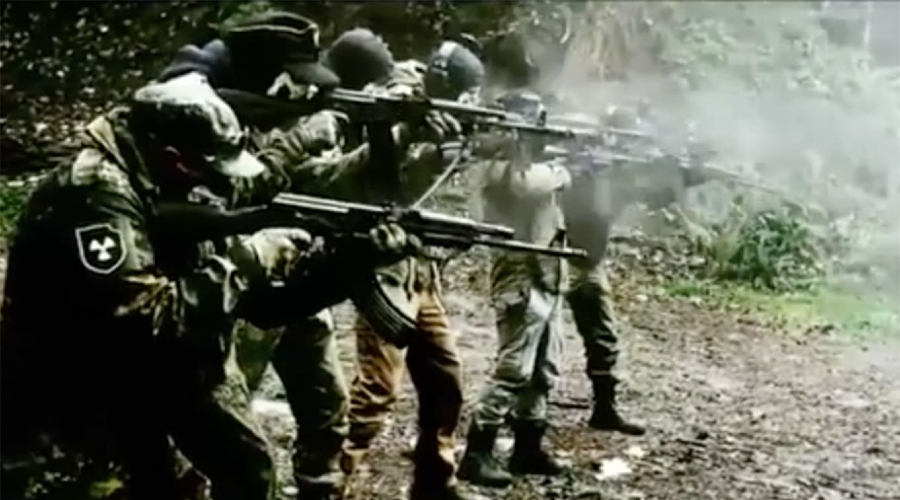What Does a "Terrorist" Designation Mean?
A label is different from enforcement—it's about sending a signal.

Published by The Lawfare Institute
in Cooperation With

Editor’s Note: Calls to officially designate antifa, Black Lives Matter or white supremacists as terrorists show the power of the terrorism label. For both legal and political reasons, however, U.S. leaders have not designated purely domestic groups as terrorist organizations. But what would designation mean? The University of Wisconsin’s Anna Meier argues that the label is more about signaling what types of groups and political actions are acceptable to the U.S. government than about fighting political violence.
Daniel Byman
***
Following incidents of far-right violence, it has become routine for politicians and pundits alike to call for designating white supremacist organizations as “terrorists” under the law. Currently, Change.org hosts 20 petitions calling for the Ku Klux Klan to be labeled a terrorist organization. Collectively these petitions have more than 3.5 million signatures. The impulse toward designation appears on the other side of the aisle as well: On May 31, President Trump announced on Twitter that he would designate antifa, a broad movement of anti-racist and anti-fascist activists, as a terrorist organization.
There is no legal mechanism in the United States for labeling purely domestic organizations as terrorist groups, but mechanisms for designating foreign actors are plentiful. The State Department’s Foreign Terrorist Organization (FTO) list made headlines last year when the Trump administration listed the Islamic Revolutionary Guard Corps, the first use of the list against a foreign military entity. Meanwhile, the U.S. recently listed the Russian Imperial Movement (RIM) under Executive Order 13224, a designation tool that applies financial sanctions—the first instance of the U.S. government officially labeling a white supremacist organization as “terrorist.”
Given this focus on designation, it is worth asking what terrorist designations are designed to do, how well they do it, and what effects they have aside from curtailing organizational capacity. Designation may combat political violence in some circumstances, but its largest effects lie elsewhere. In particular, designation signals what kinds of political contention are unacceptable to the U.S. government—and preserves this categorization as much as possible as public sentiment shifts.
The Process and Consequences of Designation
The most well-known mechanism for legally designating organizations as “terrorists” in the United States is the FTO list. Providing material support to any organization on the list—including volunteering to join a group—is a criminal activity. But the United States also has other mechanisms by which affiliation or interaction with a “terrorist” entity becomes criminalized. Executive Order 13224 applies financial sanctions to around 7,700 foreign persons and entities classified as “specially designated global terrorists,” and the Terrorist Exclusion List allows immigration authorities to bar individuals who provide material support to designated organizations from entering the country.
At first glance, these seem like strong tools for hampering organizations’ operations abroad and minimizing attacks at home. Data on the efficacy of designation tools are not always comprehensive but still suggest that designations result in numerous arrests and convictions. Since 2001, 445 people residing in the United States have been charged with “jihadist-related” terrorism; between 2001 and 2009, there were around 600 indictments across all U.S. terrorism statutes for all types of terrorism. In terms of broader counterterrorism efforts, research shows that being listed as a foreign terrorist organization can cut off an organization’s funding sources and reduce the number of attacks it commits, though these effects are highly conditional on private versus criminal funding streams and the policies of foreign governments. Others are more skeptical of these tools’ effectiveness, with former Director of National Intelligence James Clapper stating that the FTO list’s primary value is symbolic: “I can’t think of a case where somehow that [designation] facilitated our ability to track them better.” Additionally, this track record of indictments is undercut by rampant legal abuses by law enforcement, with one study finding that the average terrorism case in the post-9/11 era involving an informant or undercover agent featured numerous indicators of entrapment.
The Terrorist Exclusion List presents a particularly interesting case. Proponents of the list argue that it has been effective at limiting terrorists’ movement, a claim that is difficult to evaluate because the Department of Homeland Security does not make available comprehensive data on how many immigration and asylum cases involve terrorism statutes. Immigration court proceedings are also often private, making systematic data collection on use of the list challenging. There are several reasons to question the official narrative, however. Under various material support statutes, including those invoked under the Terrorist Exclusion List, immigrants have faced deportation for paying a ransom to the Tamil Tigers, fixing cars for rebels who threatened their families, and being kidnapped by Salvadoran guerrillas. U.S. agencies’ use of counterterrorism resources to adjudicate the immigration and asylum claims of migrants from overwhelmingly non-white countries suggests that xenophobia plays a role in the enforcement of terrorist designations, if not in the designation process itself.
Getting listed in the first place is also a politicized process. Speaking to controversy in the early 2000s over listing Pakistani militant organization the Haqqani network, Clapper cited concerns that the designation could have required also listing Pakistan as a state sponsor of terrorism because of the Haqqanis’ close cooperation with Pakistan’s Inter-Services Intelligence, which he argued would have endangered security cooperation in South Asia. The organization was ultimately listed in 2012, with strong assurances from the Obama administration that Pakistan would not receive a state sponsor designation. Similarly, the Taliban remains unlisted, as doing so would mean that negotiations with the organization would violate U.S. policy to not negotiate with terrorists. Whether or not these organizations should be listed based on some objective criteria is beside the point. What matters is that concerns about offending allies, along with larger geopolitical considerations, often take precedence in deciding which organizations do or do not get listed.
Political incentives also appeared in the April 2020 designation of the Russian Imperial Movement as a specially designated global terrorist. As the first time that a white supremacist organization received a legal classification as “terrorist” by the United States, RIM’s designation attracted substantial attention. In announcing the designation, State Department Coordinator for Counterterrorism Nathan Sales emphasized its “unprecedented” and “historic” nature. Yet, as I have written elsewhere, the RIM designation as a specially designated global terrorist is significant not because the U.S. finally applied the legal “terrorist” label to a white supremacist organization, but because RIM was a safe choice for designation among public outcry for more government action against white supremacist violence.
Understanding why designating RIM was comparatively “safe” requires noting who the administration did not designate. Despite rumors in March, the State Department did not proceed with plans to designate Atomwaffen Division, a self-described Nazi organization based in the United States with cells in Canada, Germany and other countries. Despite Atomwaffen Division’s relative weakness after multiple FBI operations against the group, designating the group would still have been a more significant policy maneuver than designating RIM because of Atomwaffen Division’s status as a U.S.-based organization. It also would have raised questions from the Department of Justice and members of Congress for shifting the State Department’s past statutory interpretations of “foreignness.” By choosing a little-known organization with no activity on U.S. soil, the Trump administration was able to declare its dedication to fighting white supremacist terrorism without calling attention to the role of U.S. actors in global white supremacist networks.
Effects of Domestic Designation
As mentioned, there is no purely domestic terrorism statute in the United States, nor is there a domestic terrorism proscription mechanism. While it is possible to charge an individual with domestic terrorism under various sections of Title 18 of the U.S. Code for committing a specific attack, membership in a domestic organization alone is not criminalized. As a result, Trump’s threat to designate antifa is an empty one, short of creating a brand-new mechanism via executive order—which, given the strong free speech protections in the United States, would immediately face a challenge in court.
Any domestic designation must also be considered in relation to U.S. law enforcement’s long history of violence against Black communities and its complicity in white supremacist violence. Free speech protections alone cannot explain why politicians and members of the public alike repeatedly call Black Lives Matter a terrorist organization, while violence committed by self-declared white supremacists is treated as a matter of mental illness. Nor can they explain nationwide calls for former Department of Homeland Security Secretary Janet Napolitano to resign after her agency released a report on the general threat of right-wing extremism, while the deaths of 11 civilians after Philadelphia police bombed a residential compound belonging to the Black liberation organization MOVE did not lead to an analogous outcry for Mayor Wilson Goode’s resignation.
Each of these examples drives home the same lessons illustrated by foreign terrorist designations: The “terrorist” label, even when not a formal legal mechanism, signals what kinds of political behavior cross the line from nonideal to unacceptable—often along racial and ethnic lines. Rebels waging an insurgency in El Salvador is nonideal; Salvadoran asylum-seekers working for their rebel captors is unacceptable. The KKK committing violence is nonideal; activists of color who challenge existing institutions that privilege white supremacy, as Black Lives Matter does, are unacceptable. And when public sentiment toward what kinds of political violence are unacceptable shifts, terrorist designations can allow the government to make changes on the margins while preserving the core of its preferred narrative. In the case of the U.S.’s first white supremacist terrorist designation, choosing RIM had high symbolic currency in a time of rising far-right extremism while still being a low-cost action in not condemning a particularly prominent or U.S.-linked organization.
Moreover, the existence of mechanisms for designating terrorists may matter less than officials’ willingness to go after organizations viewed as “terrorist.” After all, the city of Philadelphia did not have a legal backing for calling MOVE a “terrorist” organization, but the term was used to justify its tactics toward the group, both before and after the bombing. Designating an organization alone may have minimal effects on that organization’s capabilities, unless agencies allocate the resources needed to pressure the organization. However, not designating an organization could still mean that officials view it as “terrorist,” with all the attached normative baggage. And government agencies may still decide to go after a group without a designation, as they have done in the past. Paradoxically, then, a hypothetical domestic designation may simply reinforce widely held sentiments about what kinds of actors are or are not terrorists.
Trump’s threatened antifa designation, then, may not carry any legal weight, but it does signal to the public—and to law enforcement—an unacceptable form of contention in the eyes of the administration. The language of “terrorism,” more than any official terrorist designation itself, has significant implications for how the state interfaces with non-state actors.





